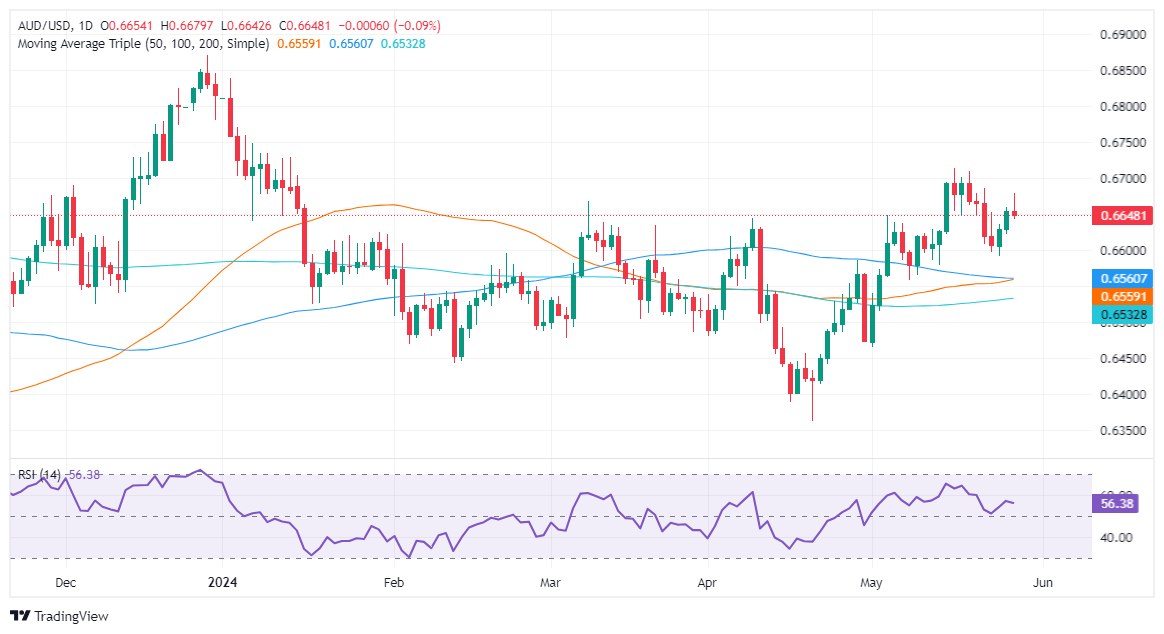- AUD/USD remains at 0.6649, unchanged as Asian session begins.
- Minneapolis Fed President Kashkari's comments on rate hikes bolster USD strength.
- Upcoming Australian CPI data may influence AUD, with potential rise aiding in recovery.
The Australian Dollar registered minuscule losses against the US Dollar on Tuesday amid higher US Treasury yields. A softer-than-expected US 5-year Treasury note auction boosted the Greenback, which posed gains versus most other currencies. As the Asian session begins, the AUD/USD trades at 0.6649, virtually unchanged.
AUD/USD trades flat as higher US yields and hawkish Fed remarks support US Dollar
Fed speakers grabbed the headlines on Tuesday, led by Minneapolis Fed President Neel Kashkari. He said, “I don’t think anybody has totally taken rate increases off the table,” while in a Q&A session, he answered he wasn’t confident about the evolution of the disinflationary process and foresees just two rate cuts.
Data-wise, the Conference Board revealed that Consumer Confidence persists after hitting 102.0 from 97.5, the highest print after posting three months of decreases. The lift was primarily driven by improved expectations meaning consumer spending may remain robust in the second half of 2024.
Aside from this, US Treasury bond yields jumped on a softer US 5-year T-note auction, with the 10-year note coupon rising seven basis points to 4.548%, a tailwind for the US Dollar.
On the Aussie’s front, the schedule would feature the Westpac Leading and the monthly Consumer Price Index (CPI) for April. Analysts estimate prices to fall from around 3.5% YoY to 3.4%, which would maintain the status quo. Otherwise, a rise exceeding expectations could benefit the AUD/USD and push prices toward the March 8 high of 0.6667.
AUD/USD Price Analysis: Technical outlook
The Aussie Dollar remains upward biased despite retreating from weekly highs of 0.6673, amid forming a ‘gravestone doji,’ which hints further downside is seen. Momentum shows that buyers are in charge, as depicted by the Relatives Strength Index (RSI) standing at bullish territory. Still, in the short term, the AUD/USD could be headed for a correction to the latest cycle low of 0.6592 before targeting the year-to-date (YTD) high of 0.6839.
Australian Dollar PRICE This week
The table below shows the percentage change of Australian Dollar (AUD) against listed major currencies this week. Australian Dollar was the strongest against the Japanese Yen.
| USD | EUR | GBP | JPY | CAD | AUD | NZD | CHF | |
|---|---|---|---|---|---|---|---|---|
| USD | -0.08% | -0.17% | 0.11% | -0.15% | -0.29% | -0.40% | -0.24% | |
| EUR | 0.08% | -0.11% | 0.22% | -0.07% | -0.28% | -0.41% | -0.13% | |
| GBP | 0.17% | 0.11% | 0.28% | 0.02% | -0.16% | -0.23% | -0.04% | |
| JPY | -0.11% | -0.22% | -0.28% | -0.31% | -0.43% | -0.44% | -0.39% | |
| CAD | 0.15% | 0.07% | -0.02% | 0.31% | -0.16% | -0.24% | -0.14% | |
| AUD | 0.29% | 0.28% | 0.16% | 0.43% | 0.16% | -0.05% | 0.11% | |
| NZD | 0.40% | 0.41% | 0.23% | 0.44% | 0.24% | 0.05% | 0.15% | |
| CHF | 0.24% | 0.13% | 0.04% | 0.39% | 0.14% | -0.11% | -0.15% |
The heat map shows percentage changes of major currencies against each other. The base currency is picked from the left column, while the quote currency is picked from the top row. For example, if you pick the Australian Dollar from the left column and move along the horizontal line to the US Dollar, the percentage change displayed in the box will represent AUD (base)/USD (quote).
Australian Dollar FAQs
One of the most significant factors for the Australian Dollar (AUD) is the level of interest rates set by the Reserve Bank of Australia (RBA). Because Australia is a resource-rich country another key driver is the price of its biggest export, Iron Ore. The health of the Chinese economy, its largest trading partner, is a factor, as well as inflation in Australia, its growth rate and Trade Balance. Market sentiment – whether investors are taking on more risky assets (risk-on) or seeking safe-havens (risk-off) – is also a factor, with risk-on positive for AUD.
The Reserve Bank of Australia (RBA) influences the Australian Dollar (AUD) by setting the level of interest rates that Australian banks can lend to each other. This influences the level of interest rates in the economy as a whole. The main goal of the RBA is to maintain a stable inflation rate of 2-3% by adjusting interest rates up or down. Relatively high interest rates compared to other major central banks support the AUD, and the opposite for relatively low. The RBA can also use quantitative easing and tightening to influence credit conditions, with the former AUD-negative and the latter AUD-positive.
China is Australia’s largest trading partner so the health of the Chinese economy is a major influence on the value of the Australian Dollar (AUD). When the Chinese economy is doing well it purchases more raw materials, goods and services from Australia, lifting demand for the AUD, and pushing up its value. The opposite is the case when the Chinese economy is not growing as fast as expected. Positive or negative surprises in Chinese growth data, therefore, often have a direct impact on the Australian Dollar and its pairs.
Iron Ore is Australia’s largest export, accounting for $118 billion a year according to data from 2021, with China as its primary destination. The price of Iron Ore, therefore, can be a driver of the Australian Dollar. Generally, if the price of Iron Ore rises, AUD also goes up, as aggregate demand for the currency increases. The opposite is the case if the price of Iron Ore falls. Higher Iron Ore prices also tend to result in a greater likelihood of a positive Trade Balance for Australia, which is also positive of the AUD.
The Trade Balance, which is the difference between what a country earns from its exports versus what it pays for its imports, is another factor that can influence the value of the Australian Dollar. If Australia produces highly sought after exports, then its currency will gain in value purely from the surplus demand created from foreign buyers seeking to purchase its exports versus what it spends to purchase imports. Therefore, a positive net Trade Balance strengthens the AUD, with the opposite effect if the Trade Balance is negative.
Information on these pages contains forward-looking statements that involve risks and uncertainties. Markets and instruments profiled on this page are for informational purposes only and should not in any way come across as a recommendation to buy or sell in these assets. You should do your own thorough research before making any investment decisions. FXStreet does not in any way guarantee that this information is free from mistakes, errors, or material misstatements. It also does not guarantee that this information is of a timely nature. Investing in Open Markets involves a great deal of risk, including the loss of all or a portion of your investment, as well as emotional distress. All risks, losses and costs associated with investing, including total loss of principal, are your responsibility. The views and opinions expressed in this article are those of the authors and do not necessarily reflect the official policy or position of FXStreet nor its advertisers. The author will not be held responsible for information that is found at the end of links posted on this page.
If not otherwise explicitly mentioned in the body of the article, at the time of writing, the author has no position in any stock mentioned in this article and no business relationship with any company mentioned. The author has not received compensation for writing this article, other than from FXStreet.
FXStreet and the author do not provide personalized recommendations. The author makes no representations as to the accuracy, completeness, or suitability of this information. FXStreet and the author will not be liable for any errors, omissions or any losses, injuries or damages arising from this information and its display or use. Errors and omissions excepted.
The author and FXStreet are not registered investment advisors and nothing in this article is intended to be investment advice.
Recommended content
Editors’ Picks

EUR/USD trades sideways below 1.0900 amid cautious optimism
EUR/USD trades sideways below 1.0900 in the early European session on Tuesday. The US Dollar looks to stabilize amid cautious optimism, as uncertainty over the US presidential election outcome lingers. US ISM Services PMI is also in focus, as Americans head to the polls.

GBP/USD rises toward 1.3000, awaits US election result
GBP/USD is rising toward 1.3000 in European trading on Tuesday, having found support near 1.2950 on a broadly subdued US Dollar. Traders eagerly await the outcome of the US presidential election, refraining from placing fresh bets on the major.

Gold price holds steady around $2,735 area amid modest USD slide, US election jitters
Gold price attracts dip-buyers after touching a one-week low on Tuesday and draws support from a combination of factors. Fed rate cut bets, declining US bond yields and subdued USD demand continue to act as a tailwind for the precious metal.

Crypto markets brace for volatility in tight race between Trump and Harris
The US presidential election is one of the most significant events in the world. Due to the influence of the country’s political decisions, policies, and economic approaches, it can significantly impact crypto and global markets.

US presidential election outcome: What could it mean for the US Dollar? Premium
The US Dollar has regained lost momentum against its six major rivals at the beginning of the final quarter of 2024, as tensions mount ahead of the highly anticipated United States Presidential election due on November 5.

Best Forex Brokers with Low Spreads
VERIFIED Low spreads are crucial for reducing trading costs. Explore top Forex brokers offering competitive spreads and high leverage. Compare options for EUR/USD, GBP/USD, USD/JPY, and Gold.
